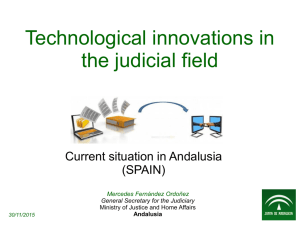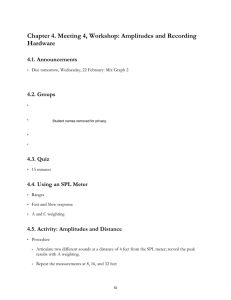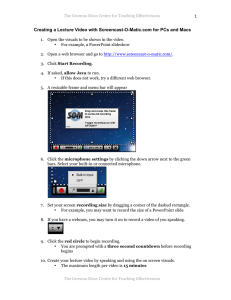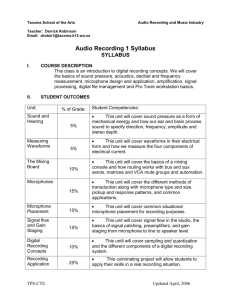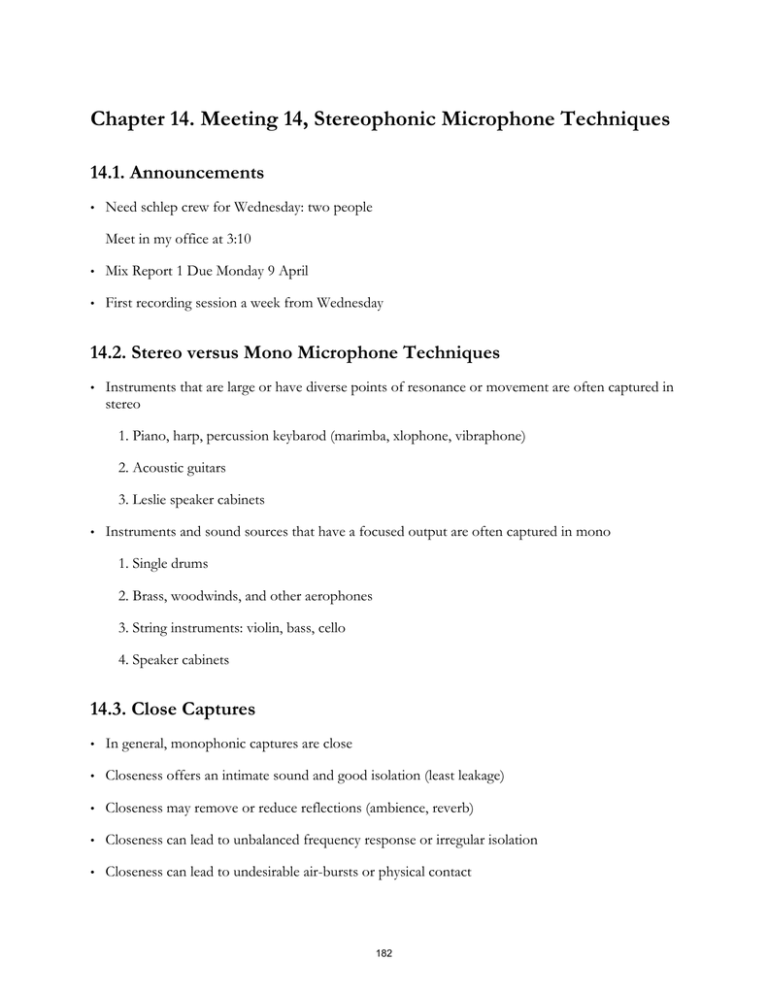
Chapter 14. Meeting 14, Stereophonic Microphone Techniques
14.1. Announcements
•
Need schlep crew for Wednesday: two people
Meet in my office at 3:10
•
Mix Report 1 Due Monday 9 April
•
First recording session a week from Wednesday
14.2. Stereo versus Mono Microphone Techniques
•
Instruments that are large or have diverse points of resonance or movement are often captured in
stereo
1. Piano, harp, percussion keybarod (marimba, xlophone, vibraphone)
2. Acoustic guitars
3. Leslie speaker cabinets
•
Instruments and sound sources that have a focused output are often captured in mono
1. Single drums
2. Brass, woodwinds, and other aerophones
3. String instruments: violin, bass, cello
4. Speaker cabinets
14.3. Close Captures
•
In general, monophonic captures are close
•
Closeness offers an intimate sound and good isolation (least leakage)
•
Closeness may remove or reduce reflections (ambience, reverb)
•
Closeness can lead to unbalanced frequency response or irregular isolation
•
Closeness can lead to undesirable air-bursts or physical contact
182
•
Ribbons (figure eight), dynamic (cardioids), and large-diaphragm condensers (cardioids) most
often used
14.4. Microphone Positioning Charts
•
Indicate musician and microphone positions
•
Circle + one arrow: cardiod
•
Circle + two arrow: figure-eight
•
Circle + cross: omni
14.5. Strings
•
Close captures of strings can be very unnatural
•
Often need some space for resonance and smoothing
•
f-holes and sound holes offer focus of output
•
Microphone diaphragm should be aligned to plane of sound board
183
Image removed due to copyright restrictions.
Mic placement for violin, Figure 4.55 in
Huber, D. M., R. E. Runstein, and D. M. Huber.
Modern Recording Techniques. Taylor & Francis, 2001.
•
Radiation is in three dimensions
184
Image removed due to copyright restrictions.
3 plots of directionality in string instruments, Figure 13-3 in
Eargle, J. The Microphone Book. 2nd ed. Focal Press, 2004.
•
Favor large-diaphrgm condensors
14.6. Acoustic Bass
•
For tone, focus large-diaphragm cadiod at f holes
•
Possibilitiy of too much bass with proximity effect: can increase distance or use an omni to
mitigate
•
Can use altenative capture of strings (abovie or below) for more performance articulations
•
Can position under strings in bridge or nut
185
Images removed due to copyright restrictions.
Two diagrams showing acoustic bass micing.
Figure 14-12 (mic mounted on bass) and 14-13 (mic on an amplifier).
In Eargle, J. The Microphone Book. 2nd ed. Focal Press, 2004.
14.7. Vocals
•
Lots of air, mouth noises, and breathing
•
Proximity to nose can increase nasal sound
•
Always use pop-screens to avoid plosives
•
From 6 to 20 inches recommended
•
Large diaphragm condensers always preferred
•
186
Images removed due to copyright restrictions.
1) Vocalist microphone is normally 0.5 to 1 meter away, Figure 13-9, in
Eargle, J. The Microphone Book. 2nd ed. Focal Press, 2004.
2) Sound reflecting off a music stand can cause comb-filtered frequency interference with
the direct sound - see Fig. 16.10 in Huber, D. M., R. E. Runstein, and D. M. Huber.
Modern Recording Techniques. Taylor & Francis, 2001.
187
Recording a Vocalist
Side view
Microphone about 0.5m
(20 in) from vocalist
Pop
Screen
Music Stand
Stool
Top view
Solid Baffles
See through
upper sections
Image by MIT OpenCourseWare.
14.8. Amps
•
Axis and orientation to speaker makes a big difference
•
Often want to be slightly off axis of speaker cone
188
© Taylor & Francis. All rights reserved. This content is excluded from our Creative
Commons license. For more information, see http://ocw.mit.edu/fairuse.
Source: Crich, T. Recording Tips for Engineers: For Cleaner, Brighter Tracks. 2nd ed. Taylor & Francis, 2005.
•
The front and back of a speaker are valuable sources
•
Position in relation to speaker matters
© Taylor & Francis. All rights reserved. This content is excluded from our Creative
Commons license. For more information, see http://ocw.mit.edu/fairuse.
Source: Crich, T. Recording Tips for Engineers: For Cleaner, Brighter Tracks. 2nd ed.
Taylor & Francis, 2005.
•
Special amps (Leslie speakers, stereo cabinets, diffuse radiating cabinets) require stereo captures
•
Favor cardioid dynamics, large diaphragm cardioids (with pad), or ribbon
189
14.9. Brass
•
Huge dyanmic range, potentially large bursts of air
•
Dynamic microphone are effective, safe, and warm
•
Favor small diaphragm condensors (with pad) or ribbon
•
On axis captures are common; off axis (or post recording filtering) may give a warmer sound
© Focal Press/Elsevier. All rights reserved. This content is excluded from our Creative
Commons license. For more information, see http://ocw.mit.edu/fairuse.
Source: Eargle, J. The Microphone Book. 2nd ed. Focal Press, 2004.
190
Image removed due to copyright restrictions.
Mic placement for trumpet should be slightly off axis.
See Fig. 4.40 in Huber, D. M., R. E. Runstein, and D. M. Huber.
Modern Recording Techniques. Taylor & Francis, 2001.
14.10. Woodwinds
•
Clarinets, saxophones, flutes, bassons
•
Sound eminates from all around (bell and keys)
191
© Focal Press/Elsevier. All rights reserved. This content is excluded from our Creative
Commons license. For more information, see http://ocw.mit.edu/fairuse.
Source: Eargle, J. The Microphone Book. 2nd ed. Focal Press, 2004.
•
Point microphone toward the alignment of the keys and bell
192
Image removed due to copyright restrictions.
Mic placement for alto saxophone, points just behind the bell.
See Huber, D. M., R. E. Runstein, and D. M. Huber.
Modern Recording Techniques. Taylor & Francis, 2001.
193
Image removed due to copyright restrictions.
Mic placement for clarinet.
See Figure 4.56 in Huber, D. M., R. E. Runstein, and D. M. Huber.
Modern Recording Techniques. Taylor & Francis, 2001.
•
For flutes, almost all sound out of keys
Image removed due to copyright restrictions.
Mic placement for flute.
See Figure 4.57 in Huber, D. M., R. E. Runstein, and D. M. Huber.
Modern Recording Techniques. Taylor & Francis, 2001.
•
Favor large or small diaphrgm condensors
194
14.11. Drum Kit
•
At most: a microphone per drum
© Focal Press/Elsevier. All rights reserved. This content is excluded from our Creative
Commons license. For more information, see http://ocw.mit.edu/fairuse.
Source:Eargle, J. The Microphone Book. 2nd ed. Focal Press, 2004.
•
At least: two overheads and a kick-drum microphone
•
Problem of leakage forces very close captures
•
Problem of drummers hitting things with sticks
14.12. Drum Kit: Cymbals
•
Overhead stereo captures used to gather cymbals and high frequencies (discussed under stereo
techniques)
•
High-hat often given a close capture: small diaphrgm cardiod condensor or dynamic
195
Image removed due to copyright restrictions. Microphone placement for cymbals: above
cymbal out of range of cymbal's rotation, pointing diagonally toward bell. Image 14-5
in Eargle, J. The Microphone Book. 2nd ed. Focal Press, 2004.
14.13. Drum Kit: Snare drum
•
Different sounds from the bottom and the top
•
Bottom may offer more snare tone
•
Off axis capture prefered
Photo courtesy of Curt Newton on Flickr.
•
Mixing top and bottom may create phasing distortion
•
Cardiod or super-cardiod dyanmic microphones are common (SM-57 is popular)
196
•
Small diaphragm condensor microphones (with high SPL handling or pads engaged) may be used
14.14. Drum Kit: Toms
•
Top will have more stick sound than bottom
•
Mic-per tom gives best isolation and stereo presentation
•
One microphone might be used for two rack-toms
•
Often more on-axis than snare microphones
Images removed due to copyright restrictions.
Mic placement for rack tom (aka mounted tom).
See Figures 4.50 and 4.51 in Huber, D. M., R. E. Runstein, and D. M. Huber.
Modern Recording Techniques. Taylor & Francis, 2001.
•
Cardiod dynamic microphones are common
•
Small diaphragm condensor microphones (with high SPL handling or pads engaged) may be used
197
14.15. Drum Kit: Kick
•
Both low and high frequency ranges are critical
•
Inside and outside captures are often used
© Taylor & Francis. All rights reserved. This content is excluded from our Creative Commons
license. For more information, see http://ocw.mit.edu/fairuse.
Source: Crich, T. Recording Tips for Engineers: For Cleaner, Brighter Tracks. 2nd ed. Taylor & Francis, 2005.
•
Can focus sound outside of drum
198
© Taylor & Francis. All rights reserved. This content is excluded from our Creative Commons
license. For more information, see http://ocw.mit.edu/fairuse.
Source: Crich, T. Recording Tips for Engineers: For Cleaner, Brighter Tracks. 2nd ed. Taylor & Francis, 2005.
14.16. Stereo Recording: Common Applications
•
Can be used for both close and distant captures
•
Pianos, acoustic guitars, keyboard percussion, drum set (overheads)
•
Ensembles, sections
14.17. Localization
•
Two sources of localization information
•
Timing differences: a single sound arrives to our ears at different times
•
Amplitude differences: a single sound arrives to our ears at different amplitudes
14.18. Stereo Recording: Common Directional Pairing
•
Pairs of cardioids
•
Pairs of omnis
•
Pairs of figure-eights
199
•
Mid/Side: cardioid and figure-eight (will discuss next meeting)
14.19. Stereo Recording: Common Positioning Archetypes
•
Coincident pairs: X-Y, M-S
•
Near-coincident pairs (ORTF, NOS, Faulkner)
•
Spaced pairs: A-B
14.20. Cardioid and Figure-Eight Coincident Pairs
•
Timing is identical; localization is due to amplitude differences
•
Common approaches use cardioid or hyper-cardioid pairs; coincident omnis will have minimal
differentiation
•
Consider which sound sources that are off- and on-axis
•
Small diaphragm condensors are preferred if less off-axis coloration is needed (Holman 2008, p.
74)
•
Matched pairs (with very similar frequency response) are used to reduce the chance of soundimage movement at different frequencies
•
Splay from 60 to 120 degrees
200
Image removed due to copyright restrictions.
Variable crossed cardioid patterns.
Figure 14-6 in Eargle, J. The Microphone Book. 2nd ed. Focal Press, 2004.
•
Blumlein array (1931): coincident crossed figure eights Works best in a wide room, with minimal side-wall reflections (Streicher and Dooley 1985)
201
Image removed due to copyright restrictions.
Crossed figure-8s and localization.
Figure 11-4 in Eargle, J. The Microphone Book. 2nd ed. Focal Press, 2004.
14.21. Cardioid and Figure-Eight Near-Coincident Pairs
•
Localization is due to both amplitude and timing differences
202
Results in good localization with a sense of depth (Streicher and Dooley 1985)
•
Front material is less off axis than with coincident pairs
•
Not used for close captures: small movements of the sound source can produce large image shifts
•
Office de Radio-Television Diffusion Française (ORTF): 6.7 inches (17 cm), 55 degrees from
forward
Frequently voted best stereo capture (Holman 2008, p. 85)
•
Nederlandsch Omroep Stichting (NOS): 11.8 inches (30 cm), 45 degrees from forward
•
Faulkner array: two bi-directional mics, 7.9 inches (20 cm), facing forward
•
Diagrams
203
Images removed due to copyright restrictions.
Several approaches to near-coincient pairs (ORTF, NOS, Faulkner, Stereo 180).
Figures 11-13 and 11-14 in Eargle, J. The Microphone Book. 2nd ed. Focal Press, 2004.
14.22. Spaced Omni Pairs
•
Localization due to both amplitude and timing effects
•
Best used for distant captures combined with closer captures
Extremely distant sounds can present negligible directional cues to the listener (Streicher and
Dooley 1985)
204
•
Omnis have more extended low frequency response and lower noise floor (Homan 2008, pp. 7374)
•
Spacing too close together results too little stereo distinction: coincident omnis are nearly
monophonic
•
Spacing too far results in audible echos between channels
Vague center imaging (Streicher and Dooley 1985)
•
Common approaches: 2 feet (.6 meters) close to performers; 10 to 30 feet used in front of large
ensembles (Holman 2008, p. 79)
•
Can use subcardiods for a bit more directionality
•
Examples
© Focal Press/Elsevier. All rights reserved. This content is excluded from our Creative
Commons license. For more information, see http://ocw.mit.edu/fairuse.
Source: Eargle, J. The Microphone Book. 2nd ed. Focal Press, 2004.
205
MIT OpenCourseWare
http://ocw.mit.edu
21M.380 Music and Technology: Recording Techniques and Audio Production
Spring 2012
For information about citing these materials or our Terms of Use, visit: http://ocw.mit.edu/terms.

